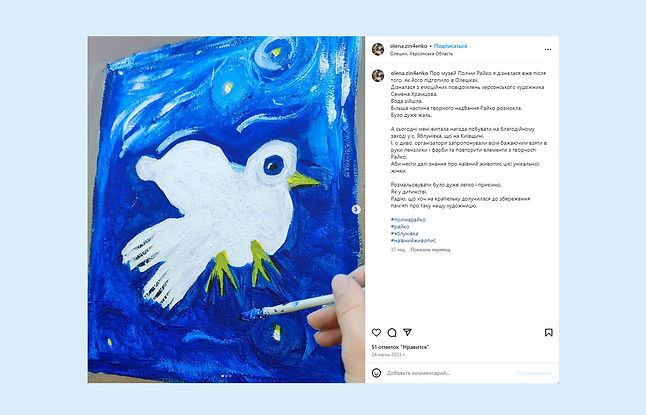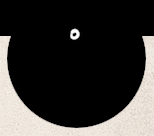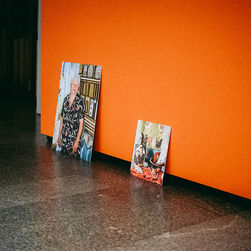
ВЖЕ СТВОРЕНІ
Tanya Kornienko
Kyiv
A calendar with portraits of Ukrainian female artists, including Polina Raiko.
Tetiana Kornienko is a digital artist who temporarily resides in Madrid because of the Russian Federation's war against Ukraine. Tetiana organizes exhibitions in Ukraine and abroad, and thus introduces Ukrainian culture to foreigners. At the end of 2023, her “Ukrainian Women Artists” project won the Catalan Feminist Art Competition in the category of “plastic arts”.
“Cultural Forces of Ukraine” platform
Kherson
“Walls of culture”
June 2023
“Walls of Culture” was initiated by activists of the “Cultural Forces of Ukraine” platform to create murals on the de-occupied and frontline territories.
In Kherson, artists Denys Lipton, Victoria Kalashnyk (Ms. Chestnut), and Oleksandra Hlavatska painted not only walls but also concrete shelters at public transport stops. Drawing for the one of the shelters was inspired by Polina Raiko's images.
Olena Zinchenko
Yablunivka village, Kyiv region
“I learned about the Polina Raiko house after it was flooded in Oleshky. I found out from the emotional messages of Kherson artist Semen Khramtsov.
The water has receded. Most of Raiko's artistic heritage was soaked.
It was very sad.
Today I had the opportunity to attend a charity event in the village of Yablunivka, Kyiv region. Surprisingly, the organizers invited everyone to pick up brushes and paints and repeat elements from Raiko's work to spread the knowledge about this unique woman's naive painting.
It was very easy and pleasant to paint, just like in childhood.
I'm glad that I contributed to preserving the memory of such an artist.”

Ukrainian House
Kyiv
August-September 2023. Exhibition “Polina Raiko. Disposed of”.
The curators calls the exhibition “a reaction to the destruction of the artist's house-museum in Oleshky, which was the result of the explosion of the Kakhovka hydroelectric power station by the Russian occupiers.”
The interpretation of the images in the exhibition is based on the materials of the book “The Way to Paradise” (2005, published by the NGO Center for Cultural Development “Totem”).

Ivan Honchar Museum
Kyiv
September-November 2023. Exhibition “Special Operation ‘Destroy Paradise’ in the museum's courtyard.
The exhibition presents photographs of the painted interiors of Polina Raiko's house, taken by the Ivan Honchar Museum's expedition team in 2013.
“Polina Raiko's story is a way of self-therapy that can be useful for every person traumatized by war, because art gives hope,” – the exhibition organizers say.

“Silpo” supermarket
Kherson

Mystetskyi Arsenal
Kyiv
Installation dedicated to Polina Raiko at the exhibition “Pure Art”, 2017.
“Pure Art” is an exhibition about «naïve» artists and their art, supplemented by works created on a «conceptual» border with contemporary, avant-garde and folk art.
Between the professional (academic) and traditional (folk art) there is a small array of extremely interesting art, which is called naïve, outsider, amateur, true, etc. This art was created by self-taught artists, who could not live without drawing. Neither technique, materials nor commercial motives were decisive in their work, but only a pure desire to create.
(from the exhibition release)
The annotation to the exhibition states that Polina Raiko's work and the entire house are “a real find and an absolutely unique artifact.”

Tatiana Adamenko
Dnipro
“I won't see Polina Rayko's house the way it was, but I will do everything I can to make the voice of Kherson region more prominent.”

NADYA DZYAK
Kyiv
The Ukrainian brand NADYA DZYAK has created a fashion collection inspired by the work of the naïve artist Polina Raiko, whose house in Oleshky was flooded after the Russians blew up the Kakhovka Dam and HPP.
In September 2023, the collection was presented at London Fashion Week as part of the Ukrainian Fashion Week International Season SS24 with the support of the USAID “Competitive Economy of Ukraine” program.
Photo: London Fashion Week - Spring Summer 2024 Ukraine Fashion Council

Charitable Foundation named after Polina Rayko, Natalia Ryzhenko, Semen Khramtsov
Kherson
“Raiko's Ghosts” - clothes from the province in the naïve style
The Charitable Foundation named after Polina Rayko and Natalia Ryzhenko have created a fashion collection of clothes that combines images from the frescoes of Oleshky artist Polina with second-hand items that have been given a second life. The authors say that this is designer clothing with benefits for the environment and art, because the collection gives a second life to two phenomena: clothes that have already been worn and the artwork of Polina Raiko, which does not exist on any canvas except for the walls of her house in the town of Oleshky, Kherson region.
The collection does not claim to recreate Polina’s art in fabric. Instead, recognizable images from the artist's work will accompany the owners in their stormy everyday lives. The leopards, fish and birds from the walls of her house are ready to fly like ghosts around the world and tell stories to anyone who is ready to hear.
The collection was exhibited at the Kherson Museum of Contemporary Art.
Semen Khramtsov, curator of the exhibition, said:
“Ghosts” is an example of conceptual design that rethinks and modernizes the cultural heritage of Polina Raiko. The reuse of clothes goes hand in hand with the artist's reincarnation. Murals become fashion, wall statics become body dynamics, painting becomes graphics, and the murals breaks down into images that become separate. Polina's colorful paradise world is transformed into Ryzhenko's monochrome earthly everyday life.”

PinchukArtCentre
Curators of the exhibition: Tetiana Kochubinska and Tetiana Zhmurko
Kyiv
“Private space”, group exhibition, 2019.
One of the PinchukArtCentre's halls recreates Polina Raiko's “own room”.
From the exhibition concept:
“In her house of seven small rooms, Raiko created her own ‘iconographic system’ of plots and images that describe her earthly life and her idea of life after death.
Having no professional education, Polina Raiko turned to creativity in the late 1990s only. The reason for this was her forced tragic loneliness: the loss of her husband, daughter, and son gave way out to chthonic energy. In her life, Polina Raiko embodied the stereotypical image of a hermit, a “half-crazy” woman who is usually misunderstood and condemned by society. Solitude opened up opportunities for unlimited creative freedom for the artist, who was physically confined to the space of “her room”.
The artist Anna Shcherbyna enters into a dialog with Polina Rayko's “room” and creates an audio work. Pronouncing zoomorphic gut sounds, she seems to raise from the depths something domestic, archaic, animal, tangential to physiological instincts, opposite to social and power...”
Photo: Semen Khramtsov. Charitable Foundation named after Polina Raiko.

Center of cultural development
“Totem”
Curator Olena Afanasieva
Oleshky
“One night at Polina Raiko's house”
A one-night art residency as part of the “Terra Futura” festival was an opportunity for artists to spend time one-on-one with Polina Raiko's house, where she is no longer present, but where her art is. An opportunity to listen, feel, fall asleep and have a dream.

Center of cultural development “Totem”
Curator Olena Afanasieva
Kherson
“Zurich 2021”: a comic book about the life and work of Polina Raiko.
It was an act of co-creation and creative dialogue of young artists with the artistic phenomenon of Polina Raiko, a unique naïve artist from the town of Oleshky in the Kherson region, which in Soviet times was called Tsurupynsk (young people used to say “Zurich”). The creative workshop was mentored by Marlene Kraus, a well-known comic book artist from Berlin.

OLIZ brand
Ukraine
A scarf with a fragment of Polina Rayko's painting.
The scarf was made by the Ukrainian brand OLIZ.
In December 2023, at the French and Ukrainian missions to the United Nations, during the pre-premiere screening of the documentary “Glory to the Heroes” about Russia's war against Ukraine, French philosopher and filmmaker Bernard-Henri Levy showed this scarf to reinforce his words. Levy's film begins with footage of the Kakhovka hydroelectric power plant being blown up. This disaster flooded 80 settlements, including Oleshky, where the house of the Ukrainian artist Polina Rayko is located.
Later, French actress Eva Green wore this scarf as a sign of support for Ukraine and its cultural heritage.

“Grono” brand
Lviv
The brand has created the “Way to Paradise” tablecloth, which got its name from the first and only catalog of Polina Raiko's artworks with the same name. “Grono” created a series of ceramic candlesticks called Polina's Flowers also, which are based on fragments of unique paintings form the house of Polina Raiko. All products are the result of high-quality handmade work by Lviv craftsmen. The ceramists fill the candlesticks by hand, then refine the details and cover candlesticks with enamel and decorate with engobes.

Juni
(Brooklyn based textile studio, USA)
USA
“Ode to the female artist”
(watercolor on paper)
Authors say:
“This one is on the behalf of two genius women Polina Rayko and Maria Prymachenko and on the behalf of all female artist that had their work destroyed by war.
Last week Putin burned down the Ivankin museum and with it 25 of Maria Prymachenko works.
Putin’s army also captured the town of Oleshki where Polina Rayko painted house stands and the conditions of the house are unknown.
So this is a little message to Putin and to all that destroy for money and power.



























































































